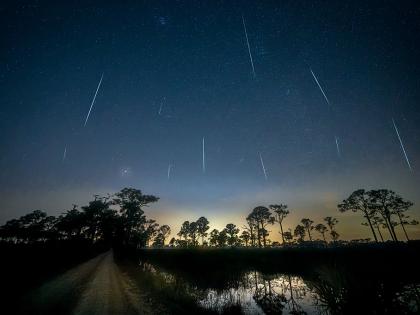All you need to know about Geminids meteor shower 2023
By Lokmat English Desk | Published: December 14, 2023 04:36 PM2023-12-14T16:36:49+5:302023-12-14T16:39:33+5:30
This year's much-anticipated Geminids meteor shower is set to peak on the night between December 14 and 15, treating ...

All you need to know about Geminids meteor shower 2023
This year's much-anticipated Geminids meteor shower is set to peak on the night between December 14 and 15, treating stargazers to a dazzling display of celestial fireworks. In India, observers can anticipate up to 150 meteors per hour during the peak time. The Geminids meteor shower is renowned for its breathtaking beauty and is named after the Gemini constellation, from which it appears to originate.
Origins and Uniqueness of the Geminids:
- Unlike most meteor showers associated with comets, the Geminids have a distinct origin linked to an asteroid known as 3200 Phaethon.
- Astronomers have debated the nature of 3200 Phaethon, with some suggesting it is a comet due to its orbit and similarity to Pallas, a main-belt asteroid.
- The Geminids exhibit a unique greenish hue, a result of the meteor's chemical composition, specifically elements like oxygen, magnesium, and nickel burning in the Earth's atmosphere.
Astronomical Phenomena and Moon's Influence:
- On the night of December 14, a waning gibbous Moon will illuminate the sky, potentially reducing visibility to 30-40 meteors per hour in the Northern Hemisphere.
- The waning gibbous Moon is a phase in which 50% of the lunar surface is illuminated, also referred to as a Half Moon.
Optimal Viewing and Online Opportunities:
- The Geminids will peak at 6:00 am CST on December 14 (5:30 pm IST), with additional viewing opportunities until December 17.
- In India, observers can witness the meteor shower from 5:30 pm IST to 7:30 am IST, preferably in locations with minimal light pollution.
- To optimize the viewing experience, stargazers should find an open field, allow their eyes to adjust to the darkness, and enjoy the cosmic wonders.
- Avoid looking directly at the Gemini constellation, as meteors near the radiant have shorter tails.
Virtual Telescope Project and Asteroid 3200 Phaethon:
- Those unable to witness the Geminids in person can catch the meteor shower online on the Virtual Telescope Project's official YouTube channel.
- Asteroid 3200 Phaethon, discovered on October 11, 1983, using the Infrared Astronomical Satellite, is associated with the Geminids shower.
- Despite lacking the icy shell characteristic of comets, some consider Phaethon a "rock comet" due to its proximity to the Sun during its orbit, resulting in heating, cracking, and debris creation.
Meteor Speed and Earth's Safety:
- The Geminids travel at speeds exceeding 125,528 kilometers per hour, roughly 40 times faster than a speeding bullet.
- Despite their high velocity, the likelihood of meteors reaching the Earth's surface is minimal, as most burn up at altitudes between 72 to 89 kilometers.
Historical Significance:
- 3200 Phaethon holds historical significance as the first asteroid associated with a meteor shower, breaking away from the conventional comet association.
- Some astronomers label Phaethon as a "dead comet," suggesting it once possessed an icy shell that eventually melted away.
As the Geminids meteor shower graces the night sky, enthusiasts are encouraged to seize the opportunity for a celestial spectacle, either in person or through virtual platforms. The beauty of the cosmos is on full display, reminding us of the wonders that unfold beyond our earthly confines.
Open in app